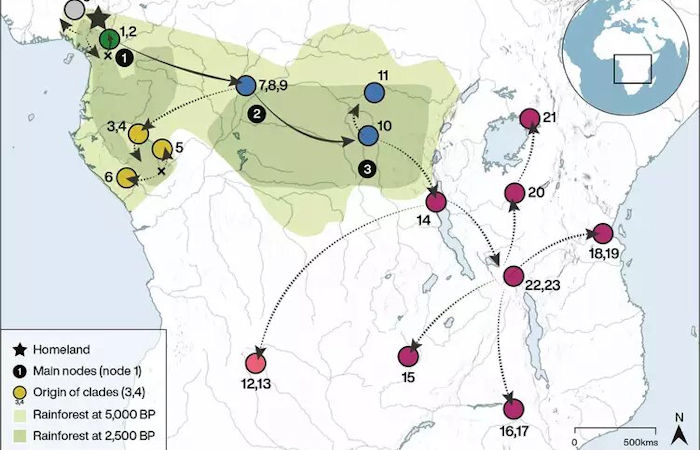Jan Bartek – AncientPages.com – The Bantu Expansion transformed sub-Saharan Africa’s linguistic, economic, and cultural composition. Today, more than 240 million people speak one of the more than 500 Bantu languages.
It is generally accepted that the ancestors of current Bantu speakers lived around 5,000 to 6,000 years before present in a region by the current border of Nigeria and Cameroon. However, until recently, it was not known how and when they succeeded in crossing southward through or around the dense Central African Rainforest to finally settle in their current locations, covering about half of the African continent.

Bantu migrations reconstructed from linguistic data. The homeland is marked with a star, the main nodes are numbered (1-3), and the origins of the main clades (0-23) are marked with their respective colors. Credit: Michelle O’Reilly
In their current study, researchers analyzed linguistic data from more than 400 Bantu and other closely related languages. From this data, using novel methods, they built a dated language family tree and reconstructed the geographic spread of Bantu speakers. In contrast to previous claims, the southwards expansion happened approximately 4,000 years ago—a long time before the savanna corridor through the dense rainforest opened. It had previously been thought that agriculturalist populations, such as the early Bantu speakers, would not have been able to maintain their agricultural traditions in a dense rainforest environment.
Linguistic data tells us a story of migrations
The authors used a novel method, borrowed from genetics, to account for possible geographic biases in the reconstruction: “It turns out that there are actually more than 600 Bantu and other related documented languages, but there is not enough lexical data available for about one third of them. Therefore, we implemented a so-called sequence-free sampling—a way to overcome this bias and build a more robust geographic reconstruction, including all documented Bantu languages,” comments Ezequiel Koile, lead author of this research. “It’s really exciting to be able to use these methods to provide the most comprehensive analysis of the Bantu languages to date. These methods give us real power to resolve these long-standing debates about major human population expansions,” adds Simon Greenhill, co-author of the study.
Besides the sequence-free sampling approach, an important methodological improvement in the reconstruction of past migration routes was the use of a “break-away” model. “According to this model, at every split in the language tree, one of the populations stays in the same place, while the other migrates. This seems more realistic than other diffusion-based methods, where both populations are forced to migrate,” explains Remco Bouckaert, developer of this geographic model.
Agriculturalists can adapt to a dense rainforest
It was previously thought that for a human group characterized by its agricultural practices, such as the early Bantu populations, it would have been hard, if not impossible, to cross the Central African rainforest. “The idea was that the dense rainforest made it very difficult to transport and maintain the crops and cattle that characterized the Bantu expansion. While changes in type of subsistence are attested in history, they tend to be relatively rare,” comments Damián Blasi, one of the article’s co-authors.
See also: More Archaeology News
This is why it had generally been accepted that these populations migrated through the Sangha River Interval—a savanna corridor that opened as a north-south strip along the rainforest around 2,500 years ago—and not directly through the rainforest. This study’s findings fit with recent anthropological results demonstrating the adaptability of humans to tropical forests. “Our results highlight the importance of niche construction in human population expansions. Of course ecology matters, but it isn’t destiny,” concludes Russell Gray, senior author of the publication.
The study was published in the journal Proceedings of the National Academy of Sciences
Written by Jan Bartek – AncientPages.com Staff Writer





